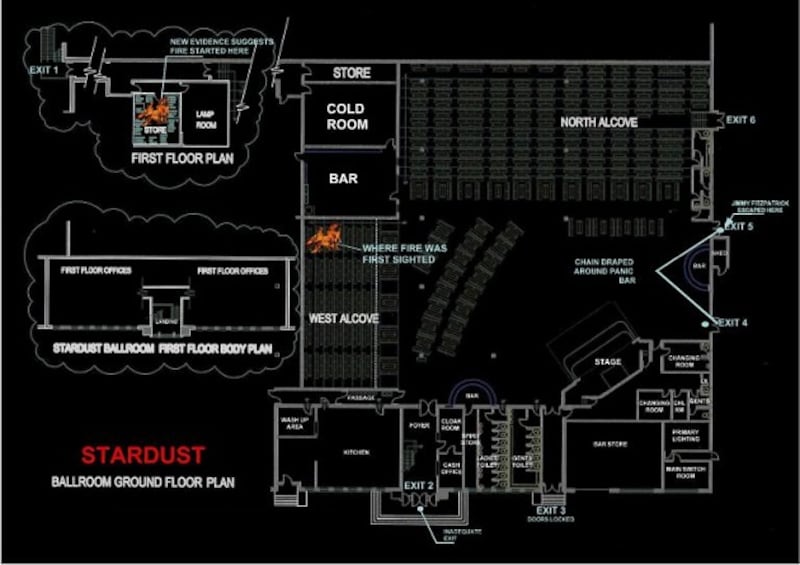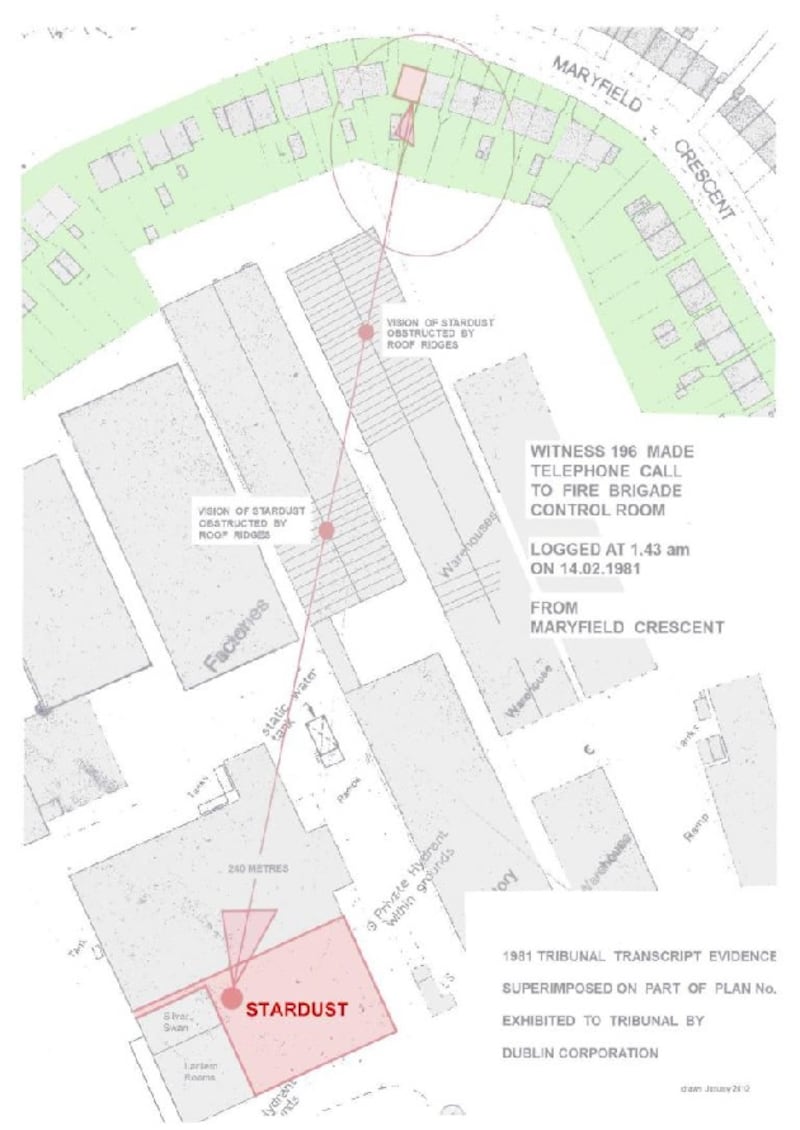The night started like every other. Excitement ran high and anticipation filled the air as over 800 young people queued up outside the former jam factory for the much anticipated Valentines disco.
Groups split up in the hopes of escaping the bouncers’ random rejection policy and reunited in the foyer where they made their way into the ballroom.
Just hours later many of the same revellers would try desperately to escape the building as the fire raged around them. Many tried to get out through fire exits, some of which were chained closed. Windows were blocked by iron bars and many were crushed in the rush to get out.
Forty-eight young people died and over 200 were injured that night. Their families are still looking for answers almost forty years later.
The cause of the fire was the subject of a tribunal of investigation chaired by Mr Justice Ronan Keane in 1982. It ruled arson as the probable cause.
The tribunal pointed to the fire starting in the west alcove of the main ballroom, but expert evidence produced on behalf of the victims’ committee suggested that the source of the fire was elsewhere.
An independent examination conducted by Paul Coffey SC in 2008 after new evidence was submitted by families of the victims dismissed the 1982 verdict of probable arson as the cause of the fire.
The official verdict of ‘probable arson,’ had been discounted many times by the families of the victims, fire expert Robin Knox and researcher Geraldine Foy.
According to these researchers the true source of the fire was not properly taken into account by the official investigation at the time.
The tribunal into the fire sat for 122 days. The report said that the Stardust did not comply with 12 public resort bye-laws, 12 fire protection standards and 6 draft building regulations.

Of the six exits in the building, the report found that the main entrance, (Exit 2) was inadequate, Exit 4 and Exit 5 had chains and padlocks draped around the panic bars and Exit 3 was chained and locked.
The tribunal report said there was no evidence of accidental origin as well as no evidence that it was started deliberately. However, it still returned a verdict of probable arson.
In light of this verdict, the owners sued Dublin Corporation for £3m in damages and were eventually awarded over £581,000. Survivors and relatives did not receive compensation until 1985. Most awards were under £20,000.
Ultimately, officials in the Coffey Report concluded that there was no need for a re-investigation into the fire.
Evidence
According to engineer Robin Knox the evidence relied upon by the Keane tribunal was seriously flawed and impacted on its ultimate findings.
Building plans submitted to the tribunal stated the storeroom and lamp room were located in a basement. Evidence shows that they were located on the mezzanine level in the roof space over the cold room.
Source of the fire
In the tribunal, the fire was said to have probably been started by a cigarette in the West Alcove. The new evidence suggested that the contents of the storeroom along with an electrical fault could have started the fire.
The committee claimed that the contents of the store room, which included 225 gallons of cooking oil and an electrical fault, were the cause of the fire.
Mr Knox believes that the fire was an incidence of ‘flash-over’ a phenomenon caused by fire spreading very rapidly through the air because of intense heat.
All burning materials emit fumes, the temperature of these fumes slowly rises until it reaches ignition point and ‘flash-over’ occurs..
Mr Knox believes that the injuries sustained by the patrons in the fire and the extent of burns on the people who died inside the Stardust would not have occurred if the fire originated in the West Alcove and spread from that point.
He told of one girl who was running through smoke towards an exit and was only seconds away from safety when she caught fire and died almost instantly.
What about the West Alcove Fire?
The West Alcove is where the fire was first seen inside the Stardust. Investigations at the time seem to rely on the belief that the fire spread up from the tiered seats, up on the walls and on the ceilings.
Emergency calls
In the Keane Tribunal, only one 999 call was taken into consideration. However three phone calls were made within seconds of each other.
A nearby resident woke up to the “sound of popping” at 1.34am. As the witness looked out her window she saw smoke rising in the distance. This phone call was discounted in the original tribunal as two buildings were blocking the resident’s view.
In another phone call at 1.43am, a resident assumed it was another building on fire but was told it was the Stardust.

Mr Knox argues that the smoke seen by this resident and another resident standing on his garage roof indicates that the fire was in the roof space before it was spotted in the West Alcove.
The events
It was near the end of the night when one patron recalled feeling a wave of heat where she was sitting at a table at the western side of the ballroom. Linda Bishop was sitting at a table near a plastic roller blind that was acting as a partition for a bank of tiered seating known as the West Alcove.
Another reveller, Jacqueline McCarthy had just returned to her seat in the western side of the ballroom when she noticed a strong smell of smoke.
Looking underneath the curtain, she saw a small fire on a small section of the seats. She immediately ran through the crowd and informed the bouncers about a fire in corner of the west alcove.
Most dancers were still unaware of the fire and continued to dance.
One of the door men, PJ Murphy, had just returned to his post after finishing an inspection of the western alcove where 3 female staff members were having their break but reportedly didn’t notice anything unusual or alarming.
He returned to the door at 1.40am and was there when Jacqueline McCarthy ran out shouting about the fire. Mr Murphy called on fellow doorman, Leo Doyle, to call the fire brigade.
Meanwhile, more and more people were starting to notice the glow in western alcove and the smell of the smoke filling the room. The DJ made the first announcement about the fire but attempted reassure the crowd that it was under control.
At the same time, a phone call was being made by Peter O’Toole reporting his girlfriend’s stolen handbag to gardaí.
Doorman Leo Doyle grabbed the phone off Mr O’Toole and gave it to another doorman, Frank Downes and told him to ring the fire brigade to report the fire.
Mr Murphy, who was back at the Western Alcove attempted to put out the fire which he described was a few inches in height. He aimed the extinguisher at the back of the seats at the same time hitting the water valve. The spray of water did little to quell the fire on the seat.
Mr Murphy remembers the feeling of “intense heat” above him from the suspended ceiling.
The doorman felt his skin burning and his hair singing as he glanced up at the ceiling but remembers that the fire seemed to be nowhere near the ceiling or the walls.
A number of employees attempted to battle the blaze, barman Lawrence Neville phoned the fire brigade at 1.43am.
The call records him asking, “Would you come down to the Stardust? There is large fire and over 800 people in here, for God’s sake, come quick, it’s getting out of control.”
Antoinette Keegan was grabbing her coat and bags with her friends and sisters when she remembers a second announcement being made to get to the nearest exit. In the rush and panic to get to the exits, Antoinette was pushed to the floor, still holding her sister’s hand.
“I remember thinking; Oh, God help us,” she said.
Antoinette woke up outside the Stardust on her own without her sisters and friends.
Jimmy Fitzpatrick remembers only one announcement from the DJ about a small fire. “There was no announcement to not panic and go towards your exits, it was just there is a small fire and then he dropped the mic and ran.”
Jimmy was one of the first people to get out of the premises that night but went back in when he saw two girls huddled together in fear.
“I remember thinking they’re not gonna get out, they’re not make it.”
Jimmy ran back in and pushed the girls to safety.
In the ballroom, the lights went out and thick heavy black smoke filled the air. People desperately tried to get out of the ballroom. The vast majority went to Exit 2, the main entrance of the Stardust.
Jimmy who had just pushed his friends to safety remembers the panic as the crowd head for the hallway in an attempt to get out.
“I tripped and I remember a couple of hundred people running across my back,” he said.
The air was thick with smoke and the fire raged over people’s heads as the suspended ceiling started to fall down on the patrons.
Some of the victims - Richard Bennett, Michael Ffrench, Murtagh (Murt) Kavanagh, Éamon Loughman and Paul Wade - were so badly burned they went undenitified until 2007.
The victims' families still reject the findings of the Keane Tribunal and continue to campaign for another examination of the evidence.
On September 25th, 2019, after decades of campaigning by the victims’ families, the Attorney General announced a fresh inquiry into the Stardust fire.













